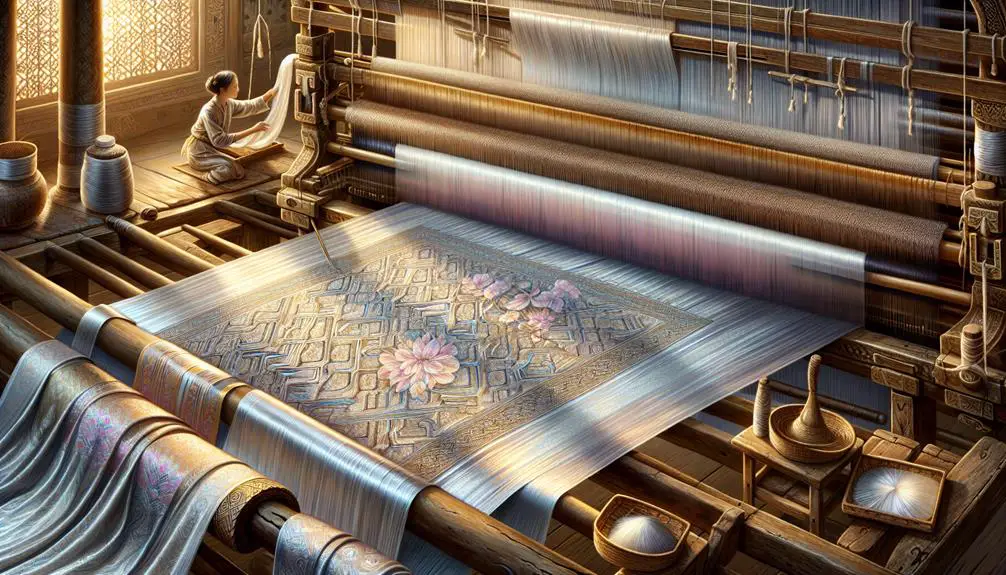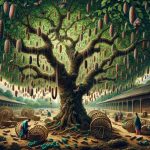The name 'silk' comes from the shiny threads spun by silkworms making their cocoons. It's a symbol of wealth and trade routes linking ancient civilizations. The fabric's history is fascinating and rich with significance. If you want to learn more about the roots and impact of silk, keep exploring its journey through time.
Table of Contents
Key Takeaways
- Named after the luxurious and prized Chinese silk fabric
- Derived from the intricate silk trade routes and exchanges
- Reflects the historical significance and value of silk in commerce
- Symbolizes the cultural and economic impact of silk production
- Represents the legacy and influence of silk on global trade dynamics
Origins of Silk Name
The origins of the name 'Silk Road' can be traced back to the lucrative silk trade that began in China. Silk, a luxurious and prized commodity, played a significant role in shaping trade routes connecting China to regions as far as the Roman Empire and Central Asia. Chinese silk was esteemed for its quality and became a symbol of wealth and status. The name 'Silk Road' aptly reflects the importance of silk as a key trade item in this ancient network of commerce.
As demand for silk grew, it influenced the establishment of trade routes that facilitated the exchange of not just goods but also ideas and cultures. The allure of Chinese silk was so strong that it fostered connections between distant civilizations, fostering economic prosperity and cultural exchange. The Silk Road, with silk at its core, became a conduit for both material wealth and the enrichment of civilizations through the interactions it fostered.
Silk Fiber Composition
Comprising primarily of fibroin, silk is a natural protein fiber derived from the cocoons of the mulberry silkworm larvae. This protein fiber, known for its lustrous appearance and smooth texture, is a result of a fascinating process. Silk is mainly produced by insects that undergo complete metamorphosis, with the mulberry silkworm being the most well-known producer. The mulberry silkworm is distinct from wild silks and has been historically linked to China.
The composition of silk, with fibroin as its main component, contributes to its strength and sheen. When the silkworm larvae are ready to enter the pupal stage, they secrete fibroin to form their cocoons. These cocoons are then harvested and processed to extract the silk fibers. The intricate process of silk production highlights the significance of the mulberry silkworm in creating this luxurious and valuable fiber.
Mulberry Silkworm Connection
So, let's discuss why mulberry trees and silkworms are so interconnected when it comes to silk production.
Mulberry trees provide the primary food source for silkworms, which play an essential role in silk production.
This historical relationship between mulberry trees and silkworms goes back thousands of years, shaping the foundation of sericulture as it's understood today.
Mulberry Tree Importance
Nestled within the intricate web of silk production, lies the essential mulberry tree, a silent yet essential partner in the journey of the silkworm.
The mulberry tree plays a significant role in silk production by providing the primary food source for silkworms. Its leaves are rich in nutrients necessary for the silkworms' growth and the subsequent production of silk. This relationship is key to the sustainability and success of the silk industry.
Without the mulberry tree, the process of feeding silkworms and harvesting silk wouldn't be possible. The mulberry tree's significance as the foundation of silk production underscores its importance in the entire silk-making process.
Silkworm Silk Production
The mulberry silkworm's connection to silk production is a fundamental aspect of the intricate process that has captivated civilizations for centuries. Here are some key points:
- Origin: Silk production began in ancient China during the Neolithic period.
- Silkworm Type: The most famous silk comes from the cocoons of the larvae of the mulberry silkworm.
- Expansion: Silk was initially limited to China until the opening of the Silk Road in the 1st millennium BC.
- Luxurious Appeal: Chinese silk quickly gained popularity as a luxury fabric among merchants and in regions accessible to them.
Sericulture History Roots
As we explore the origins of sericulture and its connection to the mulberry silkworm, we uncover a rich history dating back thousands of years in China.
Sericulture, the cultivation of silkworms for silk production, has ancient roots in China, with the production of silk fabric initially reserved for the Emperors. Chinese silk quickly became a sought-after luxury fabric, spreading through trade routes accessible to Chinese merchants.
This expansion of Chinese silk trade led to the establishment of the Silk Road, connecting China to regions like the Indian subcontinent, the Middle East, Europe, and North Africa. The name 'Silk' in the Silk Road reflects the significance of this highly prized commodity in ancient trade networks.
Historical Significance of Silk
In tracing the historical significance of silk, one can't overlook its crucial role in shaping ancient trade networks and cultural exchanges.
- Chinese silk was a highly sought-after commodity along the Silk Road trade routes, connecting the East and the West through intricate trade networks.
- The luxurious nature of Chinese silk in Rome led to its symbolic association with decadence, prompting regulations to control its use.
- Despite these restrictions, the demand for silk persisted, fostering extensive trade relationships between Rome, China, and India, enriching these civilizations.
- The production of silk remained a closely guarded secret in China, ensuring its value and monopoly until the 6th century C.E., when the secret eventually spread.
Silk trade networks played a crucial role in facilitating not only the exchange of goods but also the interchange of ideas and cultures, shaping the course of history and influencing the development of societies along these routes.
Spread via Silk Road
Having traversed ancient trade routes, Chinese silk intricately weaved its way to distant lands, spreading its luxurious allure along the Silk Road. This legendary network of trade routes connected China to central cities in Asia, the Middle East, and Europe, facilitating the exchange of not only silk garments but also ideas, technologies, and cultures.
Silk production techniques, closely guarded by the Chinese Emperor, were transmitted along these land and sea routes to regions hungry for the coveted silk textiles. The legacy of the Silk Road lies not only in the flourishing international trade it fostered but also in the profound impact it had on the development of civilizations through the exchange of ideas and knowledge.
The demand for silk in different regions acted as a driving force behind the expansion of this intricate web of trade routes, solidifying silk as a symbol of luxury and prosperity worldwide.
Influence on Global Trade
The influence of silk on global trade was immense. It expanded trade routes, boosted economies, and acted as a facilitator for cultural exchange.
The impact of silk on commerce went far beyond just being a luxurious commodity, shaping the interconnectedness of societies worldwide.
Trade Routes Expansion
How did the expansion of trade routes influence global trade dynamics?
The Silk Road's growth had a significant impact on shaping interconnected economies and fostering cultural exchanges. Here are four key ways in which the expansion of trade routes influenced global trade:
- Increased Demand for Silk: The expansion of trade routes led to a surge in the demand for Chinese silk as a luxury good.
- Diversification of Goods: Along with silk, a variety of goods including spices, precious metals, and ceramics were traded, enriching global commerce.
- Technological Exchange: The exchange of technologies such as papermaking and printing revolutionized communication and knowledge dissemination.
- Wealth Redistribution: The flow of goods and wealth along trade routes helped redistribute economic power and influence among different regions.
Economic Growth Impact
The expansion of trade routes through the Silk Road not only transformed global commerce but also played a pivotal role in driving economic growth impacts on a global scale.
The silk trade, bridging the East and West, was instrumental in boosting economic growth and facilitating global trade. Chinese silk, a highly sought-after commodity, served as a key catalyst in shaping the interconnected trade networks along the Silk Road.
The demand for silk spurred the creation of extensive trade routes, fostering cultural exchanges and economic prosperity for various civilizations. Silk production and trade not only enriched economies but also laid the foundation for increased trade activities, influencing the growth trajectories of nations linked through this ancient network.
Cultural Exchange Facilitator
Playing a significant role in shaping global trade dynamics, the Silk Road acted as a vibrant hub for cultural exchange and technological diffusion between East and West.
- Chinese silk, known for its exquisite quality, was a coveted luxury item that symbolized wealth and status along the trade routes.
- The exclusivity of Chinese silk, guarded as a closely held secret by the Chinese for centuries, added to its allure and value in global trade.
- The exchange of silk not only facilitated economic growth but also served as a medium for cultural diffusion, spreading ideas, beliefs, and practices between different regions.
- Through the Silk Road, technological transfers occurred, with innovations in silk production techniques and other crafts being shared and adopted across Eurasia.
Modern Uses of Silk
Utilizing silk in various industries, such as fashion, medicine, and beauty, showcases its versatility and practicality in modern applications. In high-end fashion and luxury clothing, silk's smooth texture and lustrous appearance make it a sought-after fabric for elegant garments. Home furnishings like bedding, curtains, and upholstery also benefit from silk's elegance and durability, adding a touch of sophistication to interiors.
In the medical field, silk is valued for its biocompatibility and strength, commonly used in sutures and medical textiles. Its strength and flexibility also make it a preferred material for producing parachutes and high-quality musical instrument strings, ensuring reliability and performance in critical applications.
Moreover, the beauty industry harnesses the moisturizing and conditioning properties of silk proteins in skincare products and hair treatments. This natural component provides nourishment and care, enhancing the effectiveness of various beauty formulations. The enduring appeal and multifaceted nature of silk continue to make it a staple in modern industries, blending luxury with functionality seamlessly.
Frequently Asked Questions
Why Is the Silk Road an Unusual Name?
The Silk Road's name may seem unusual because it's not a literal road but a network of ancient trade routes. Its rich history and cultural impact make it a fascinating study on the interconnectedness of civilizations.
Why the Title Has Been Named as Silk Road?
The title 'Silk Road' signifies the historical significance of silk trade in connecting civilizations. Chinese silk, a luxury sought-after commodity, drove economic and cultural exchanges. Silk symbolized wealth and sophistication, shaping interactions along ancient trade routes.
Is the Silk Road the Correct Name?
The term "Silk Road" is widely accepted as the name for the ancient trade routes connecting East and West, despite debates. It signifies the lucrative silk trade that flourished, emphasizing the cultural and economic exchanges.
What Was the Silk in the Song Dynasty?
In the Song Dynasty, silk was a luxurious fabric made from silkworm cocoons. It was prized for its quality, fine texture, and vibrant colors. Advanced dyeing and weaving techniques were used, making it a significant export item.
- Why Is Red Velvet Not Red? - April 25, 2024
- How Do You Describe Velvet Fabric? - April 25, 2024
- How Strong Is Velvet? - April 25, 2024








